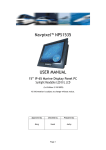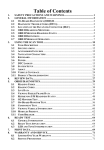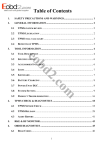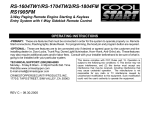Download Autel TS501 User Manual
Transcript
Table of Contents 1. SAFETY PRECAUTIONS AND WARNINGS .............................................. 1 2. TOOL INFORMATION .................................................................................. 2 2.1 TOOL DESCRIPTION ...................................................................................... 2 2.2 SPECIFICATIONS ............................................................................................ 4 2.3 ACCESSORIES INCLUDED............................................................................... 4 2.4 ICONS ............................................................................................................ 4 2.5 KEYBOARD .................................................................................................... 5 2.6 BATTERY CHARGING .................................................................................... 5 2.7 POWER UP BY DLC....................................................................................... 6 2.8 SYSTEM SETTING .......................................................................................... 6 2.9 PRODUCT TROUBLESHOOTING.................................................................... 13 3. ACTIVATING & DIAGNOSING ................................................................. 15 3.1 ACTIVATING ................................................................................................ 15 3.2 VEHICLE SELECTION .................................................................................. 15 3.3 TPMS RELEARN ......................................................................................... 24 3.4 LATEST SCAN .............................................................................................. 33 3.5 REVIEW DATA ............................................................................................. 34 4. RKE & RF MONITOR .................................................................................. 38 5. PRINT AND UPDATE................................................................................... 38 5.1 PRINT DATA ................................................................................................ 38 5.2 SOFTWARE UPDATE .................................................................................... 39 6. WARRANTY AND SERVICE ...................................................................... 45 6.1 LIMITED ONE YEAR WARRANTY ................................................................ 45 6.2 SERVICE PROCEDURES ................................................................................ 45 1. Safety Precautions and Warnings To prevent personal injury or damage to vehicles and/or the scan tool, read this instruction manual first and observe the following safety precautions at a minimum whenever working on a vehicle: Always perform diagnosis or service in a safe environment. Wear safety eye protection that meets ANSI standards. Keep clothing, hair, hands, tools, test equipment, etc. away from all moving or hot engine parts. Operate the vehicle in a well ventilated work area: Exhaust gases are poisonous. Put blocks in front of the drive wheels and never leave the vehicle unattended while running tests. Use extreme caution when working around the ignition coil, distributor cap, ignition wires and spark plugs. These components create hazardous voltages when the engine is running. Keep a fire extinguisher suitable for gasoline/chemical/electrical fires nearby. Put the transmission in PARK (for automatic transmission) or NEUTRAL (for manual transmission) and make sure the parking brake is engaged. Refer to the user’s manual for the vehicle being serviced and adhere to all diagnostic procedures and precautions. Otherwise personal injury or unneeded repairs may result. Keep the TPMS tool dry, clean, free from oil, water and grease. Use a mild detergent on a clean cloth to clean the outside of the TPMS tool when necessary. 1 2. Tool Information 2.1 Tool Description 1) RUBBER BOOT – Protects the TPMS tool from drop, abrasion and etc. 2) LCD DISPLAY – Displays the menus and test screens. 3) N BUTTON – Cancels a selection (or action) from a menu or return to previous menu. 4) UP SCROOL BUTTON – Moves up through menu and submenu items in menu mode. When more than one set of data are retrieved, use this button to move up to previous screens for additional data. It is also used to view previous trouble code when viewing DTCs. 2 5) 6) 7) LEFT SCROLL BUTTON –When scroll through a screen of data or text, moves to previous character and views additional information on previous screens if recorded data content covers more than one screen. HELP BUTTON – Provides help information. POWER BUTTON – Turns on/off the tool. 8) DOWN SCROOL BUTTON – Moves down through menu and submenu items in menu mode. When more than one set of data are retrieved, use this button to move down to next screens for additional data. It is also used to view next trouble code when viewing DTCs. 9) RIGHT SCROLL BUTTON – When scroll through a screen of data or text, moves to next character and view additional information on next screens if recorded data content covers more than one screen. 10) 11) TEST BUTTON – Commence a TPM Test. Y BUTTON – Confirms a selection (or action) from a menu. 12) USB PORT – Connects the TPMS tool to PC for software update, data printing or battery charging. 13) POWER PORT – Connects the TPMS tool to the mains with the charger supplied for battery charging. 14) SD CARD SLOT – Holds SD card. 15) OBD II CONNECTOR – Connects the TPMS tool to the vehicle’s Data Link Connector (DLC). NOTE: When using external power, the scan tool stays on until you turn it off. When using internal battery power, the scan tool turns off automatically after a set time of inactivity (see 2.8 System Setting). 3 2.2 Specifications 1) Display: TFT color display (320 x 240 dpi) 2) Power: 3.7V Li-polymer battery 3) Operating Temperature: 0 to 50°C (32 to 122 °F) 4) Storage Temperature: -20 to 70°C (-4 to 158 °F) 5) Dimensions: Length 202.2 mm (7.96") 6) Width 106.7mm (4.20") Height 37.7 mm (1.48") Weight: 0.4kg (0.88lb) 2.3 Accessories Included 1) User’s Manual -- Instructions on tool operations 2) OBDII Cable -- Provides power to tool and communicates between tool and vehicle 3) USB Cable -- Allows easy online update, data printing, and power charging via PC connection. 4) Protective Nylon Case -- A nylon case to store the tool when not in use 5) Magnet -- Used to trigger magnetically activated sensors (early model TPM sensors) 6) Charger -- Charges or recharges the built-in battery 7) CD -- Includes user’s manual, MaxilinkII Kit, etc. 8) SD Card -- Used to store data 2.4 Icons 1) “ ” – Indicates battery charging. 2) “ ” -- Indicates there is data stored in the tool. 4 3) “ ” -- Indicates battery volume. 4) “ ” -- Indicates USB communication with the computer is established. 5) “ ” -- Indicates magnet is required when activating TPMS sensor. 6) “ ”-- Indicates deflation is required when activating TPM sensor. 7) “ ” -- Indicates test mode One Wheel in the system setting of Wheels to Test was selected. 8) “ ” -- Indicates test mode ALL Wheels in the system setting of Wheels to Test is selected. 9) “ ” – Indicates the TPMS tool is sending signals to the tire sensor for activation and test. 10) “ ” – Indicates tool communication with the vehicle’s OBDII DLC. 2.5 Keyboard No solvents such as alcohol are allowed to clean the keypad or display. Use a mild nonabrasive detergent and a soft cotton cloth. Do not soak the keypad as the keypad is not waterproof. 2.6 Battery Charging The TPMS tool has a 3.7v built-in lithium-ion polymer rechargeable battery. There are two means of battery charging: To charge battery by adapter. 1) Locate the power port of the device. 2) Connect the device to the mains with the charger to start charging. 5 To charge battery by USB cable 1) Locate the USB port of the device. 2) Connect the device to computer with the charger to start charging. IMPORTANT: Charge battery in time, otherwise the test results may be incorrect. 2.7 Power Up by DLC The tool can also be powered via the vehicle Data Link Connector (DLC). Just follow the steps below to turn on the scan tool: 1) Connect the OBDII Cable to the TPMS tool. 2) Find DLC on vehicle. A plastic DLC cover may be found for some vehicles and you need to remove it before plugging the OBDII cable. 3) Plug OBDII cable to the vehicle’s DLC. 4) Power up the TPMS tool by pressing the Power Button, and wait for the Main Menu to appear. (Figure 2.1) Figure 2.1 OBDII connection does not support battery charging. 6 2.8 System Setting The tool allows you to make the following adjustments and settings. 1) Language: Selects the desired language. 2) Beep Set: Turns on/off key-press beep. 3) ID Format: Sets the ID displaying in Hexadecimal or Decimal. 4) Pressure Unit: Sets the pressure unit in Kpa, Psi or Bar. 5) Temperature Unit: Sets the temperature unit in degree Celsius or Fahrenheit. 6) Wheels to Test: Gives the operator the choice to test One wheel or All wheels. 7) Auto Power-off: Sets the time to power off automatically. 8) About: Views important information of the tool. Settings of the unit will remain until change to the existing settings is made. To enter the Setting menu From the Main Menu: Use the UP/DOWN and LEFT/RIGHT scroll button to select Setting, and press the Y button. Following the instructions to do adjustments and settings could make TPMS testing more convenient and easy. (Figure 2.2) Figure 2.2 7 Language English is the default language. 1) From System Setting screen, use the UP/DOWN scroll button and LEFT/RIGHT scroll button to select Language, and press the Y button. 2) Use the UP/DOWN scroll button and LEFT/RIGHT scroll button to select the desired language and press the Y button to save your selection and return to previous menu. (Figure 2.3) Figure 2.3 Beep Set This function allows you to turn on/off the build-in speaker for key pressing. 1) From System Setting screen, use the UP/DOWN scroll button and LEFT/RIGHT scroll button to select Beep Set, and press the Y button. 2) From Beep Set menu, use the LEFT/RIGHT scroll button to select ON or OFF to turn on/off the beep.(Figure 2.4) 8 Figure 2.4 3) Press the Y button to save your selection or the N button to exit without change. ID Format 1) From System Setting screen, use the UP/DOWN scroll button and LEFT/RIGHT scroll button to select ID Format, and press the Y button. 2) From ID Format screen, use the LEFT/RIGHT scroll button to select the desired format of ID. (Figure 2.5) Figure 2.5 3) Press the Y button to save your settings and return to previous menu. Or, press the N button to exit without change. 9 Pressure Unit 1) From System Setting screen, use the UP/DOWN scroll button and LEFT/RIGHT scroll button to select Pressure Unit, and press the Y button. 2) From Pressure Unit screen, use the LEFT/RIGHT scroll button to select the desired unit: Kpa, Psi or Bar. (Figure 2.6) Figure 2.6 3) Press the Y button to save your settings and return to previous menu. Or, press the N button to exit without change. Temperature Unit 1) From System Setting screen, use the UP/DOWN scroll button and LEFT/RIGHT scroll button to select Temperature Unit, and press the Y button. 2) From Temperature Unit screen, use the LEFT/RIGHT scroll button to select the desired unit of temperature.(Figure 2.7) 10 Figure 2.7 3) Press the Y button to save your settings and return to previous menu. Or press the N button to exit without change. Wheels to Test This function gives you choice to test TPM sensor in ALL Wheels mode or One Wheel mode. 1) From System Setting screen, use the UP/DOWN scroll button and LEFT/RIGHT scroll button to select Wheels to Test, and press the Y button. 2) From Wheel to test screen, use the LEFT/RIGHT scroll button to select All Wheels or One Wheel to test TPM sensors. (Figure 2.8) Figure 2.8 11 3) Press the Y button to save your selection or the N button to exit without change. NOTE: In All Wheels mode, the tool will determine if a duplicate sensor ID has been read. In this case, the tool will display a message “Sensor ID Duplicate.” In One Wheel mode, the tool will not check the duplicate sensor ID. Auto Power-off 1) From System Setting screen, use the UP/DOWN scroll button and LEFT/RIGHT scroll button to select Auto Power-off, and press the Y button. 2) Press UP/DOWN SCROLL button to increase or decrease the time to auto power-off the tool, and then press the Y button to confirm your change or the N button to exit without change. (Figure 2.9) Figure 2.9 NOTE: Before the tool powers off automatically, it will save all the TPM test data. Next time when the tool is powered on, you may retrieve the recorded data. If the tool automatically power off during a test operation, next time when the tool is powered on, it will automatically turn to the previous operation screen. 12 About This function allows viewing of some important information such as serial number and software version number of the tool. 1) From System Setting screen, use the UP/DOWN scroll button and LEFT/RIGHT scroll button to select About, and press the Y button; wait for the About screen to appear. 2) View tool information on screen. (Figure 2.10) Press the N button to exit. Figure 2.10 2.9Product Troubleshooting This part describes problems that you may encounter while using the TPMS tool. Vehicle Linking Error A communication error occurs if the TPMS tool fails to communicate with the vehicle’s ECU (Engine Control Unit) when running the diagnostic function. You need to do the following to check up: Verify that the ignition is ON. Check if the TPMS tool’s OBD II connector is securely connected to the vehicle’s DLC. Verify that the vehicle is TPMS compliant. 13 Turn the ignition off and wait for about 10 seconds. Turn the ignition back to on and continue the testing. Verify the control module is not defective 14 3. Activating & Diagnosing The MaxiTPMS® TS501 is a new generation TPMS diagnostic & service tool specially designed to activate all known OEM/Universal TPMS sensors, as well as provide users with direct access to the vehicle’s ECU through OBDII connection, thus allowing users to reprogram sensor IDs and retrieve/clear TPMS DTCs, helping technicians to quickly find out faulty TPMS and turn off MILs. NOTE: All software screens shown in this manual are examples, actual test screens may vary for each vehicle being tested. Observe the menu titles and onscreen instructions to make correct option selections. 3.1 Activating The sensor activation function allows activating of TPM sensor to view sensor data such as sensor ID, tire pressure, tire temperature, sensor battery, sensor position, frequency. It also sends the sensor data to vehicle’s ECU to let the ECU learn the positions of sensors whenever tires and wheels are rotated or sensors are replaced. There are two means of activating a TPM sensor: A. Vehicle Selection--To activate the sensor by selecting vehicle make, model and year. B. Latest Scan--The TPMS tool automatically records the latest activated sensor and it activates the sensor by using the wave signal of the latest trigger event. So Latest Scan is very useful for technicians to wake up sensors of the same vehicle. 3.2 Vehicle Selection 1) Use the UP/DOWN scroll button and LEFT/RIGHT scroll button to select Vehicle Selection from Main Menu (Figure 2.1), and press the Y button to confirm. 2) Select a specific vehicle manufacture’s regional coverage. (Figure 3.1) 15 Figure 3.1 3) From the vehicle make screen, select a specific vehicle manufacture and press the Y button. (Figure 3.2) Figure 3.2 4) Observe the menu title and use UP/DOWN SCROLL button to select by model and year to identify the vehicle being tested, place the device alongside the valve stem and press the Y button. (Taking Chrysler as an example) The selected vehicle is remembered by the tool when a test is commenced. 16 Select by Model: Figure 3.3 Select by Year: Figure 3.4 5) For some vehicle types an option screen will show up to let users choose between 4 Wheels test and 5 Wheels test mode.(Figure 3.5) 17 Figure 3.5 Depending upon the reading mode (All Wheels or One Wheel), results are displayed in different manners. All Wheels Mode In this mode, a function menu screen will show up (Figure 3.6), users can either use the UP/DOWN and LEFT/RIGHT scroll button to select a desired wheel and press the TEST BUTTON to start sensor activation directly (Figure 3.7), or press the Y button to enter sensor activating screen. (Figure 3.8) Figure 3.6 In the above menu screen (Figure 3.6), there’s also an option for the TPMS Relearn function on the upper right side, which provides users access to the vehicle’s ECU to reprogram the sensor data and retrieve/clear DTCs, please refer to 3.3 TPMS Relearn for more information. 18 Figure 3.7 Figure 3.8 In the sensor activating screen (Figure 3.8), the tool will do TPMS test in a sequence of LF (Left Front), RF (Right Front), RR (Right Rear), LR (Left Rear) and SPARE, if the vehicle has the option for the spare. Use UP/DOWN or LEFT/RIGHT scroll button to move to the desired wheel for testing. Place the tool alongside the valve stem and point toward the sensor location and then press TEST BUTTON. The tool will send LF signal to trigger the sensor. Depending on the sensor type, the tool will activate the sensor on the first or last step. Once the sensor is successfully activated and decoded, the tool will display as below with an audible beep. (Figure 3.9) 19 Figure 3.9 Once the first sensor test is completed, the screen will hold for 3 seconds for viewing and then switch to next sensor test. Follow the same procedure for the rest of the three or four wheels by pressing UP/DOWN SCROLL button and then TEST BUTTON. Sensor data is stored and can be accessed by pressing the Y button. NOTE: A test result icon will display alongside the wheel, indicating the wheel test is completed, otherwise there’s no result icon displayed. One Wheel Mode In this mode the screen will show as below. Figure 3.10 20 In one wheel mode, the tool will do TPMS test for single wheel. Place the tool alongside the valve stem and point toward the sensor location and then press TEST BUTTON. The tool will send LF signal to trigger the sensor. Depending on the sensor type, the tool will activate the sensor on the first or last step. Once the sensor is successfully activated and decoded, the tool will display as below with an audible beep. (Figure 3.11) Figure 3.11 Once the first sensor test is completed, the screen will hold for 3 seconds for data viewing and then switch to next sensor test. Follow the same procedure for the other sensor tests by pressing UP/DOWN SCROLL button and then TEST BUTTON. The tool can save up to 10 TPM sensor data records at any one time. Press UP/DOWN or LEFT/RIGHT scroll button to turn over data screens while viewing. If sensors being tested are more than ten pieces, the latest record will overwrite the first one. 21 TABLE 1 POSSIBLE RESULTS FOR TESTING Icon Test Results Description √ Successful Sensor Read TPM sensor is successfully activated and decoded. The tool displays the sensor information. X Failed Sensor Read If the search period expires and no sensor is activated or decoded, it may be wrong sensor fitment or non-functioning sensor. The tool displays a message “No sensor detected.”. In this case, repeat test to confirm the TPM failure. X Wrong Sensor Type A TPM sensor is activated and decoded, but does not match the protocol for the Make Model Year that the tool was set-up for. The tool displays a message “Sensor triggered but cannot be known.”. In this case, verify the Make Model Year you have selected as well as the sensor part number that was fitted. D Duplicate ID (only checked in All Wheels mode) A sensor with a duplicate ID has been read. The tool displays a message “Sensor ID Duplicated.”. In this case, clear data and re-read again. NOTE: With Ford Banded sensors, the tool should be held 180 degree away from the stem. Please refer to vehicle user’s manual. 22 If the TPM sensor requires a magnet, place the magnet over the stem and then place the tool alongside the stem, and press TEST BUTTON. Figure 3.12 If the TPM sensor requires tire deflation (of the order of 10PSI), then deflate the tire and place the tool alongside the stem while pressing the TEST BUTTON. Figure 3.13 Anytime while doing the TPMS test, press BUTTON to read the sensor make, OEM part no., and relearn information for the vehicle being tested. 23 Figure 3.14 Sensor activation can be aborted at any time by pressing the N button. When the activation is aborted, the user will be returned to the previous menu. By pressing the Y button, you may review information of all sensors tested. Press the LEFT/RIGHT scroll button to turn over data screens while viewing. Figure 3.15 24 Figure 3.16 3.3 TPMS Relearn This function, which provides users with quick access to the vehicle’s ECU, supports TPMS Diagnosis for sensor data writing/reading & DTCs retrieving/clearing, and saves data for later reviews. 1) Connect the TPMS tool to the vehicle’s DLC with the OBDII cable. Press the POWER BUTTON to turn on the tool. 2) Turn the ignition on but do not start the engine. 3) Make sure the testing mode is set to All Wheels mode in System Setting. 4) Follow the same process in 3.2 Vehicle Selection to the All Wheel Mode function menu screen, use the UP/DOWN scroll button and LEFT/RIGHT scroll button to select the Relearn function. (Figure 3.17) 25 Figure 3.17 5) An option screen will appear, use UP/DOWN scroll button to select TPMS Diagnosis function in the menu, and press the Y button to continue. (Figure 3.18) Figure 3.18 For some vehicles users may be asked to choose the specific engine model or other features before turning to the function menu. If you wish to read the sensor make, OEM part no., and relearn information for the vehicle being serviced, please select TPMS Sensor Information in the above screen. NOTE: In this manner, the scan tool will communicate with the vehicle being tested. If there is a linking error, a notice screen will show up, please refer to 2.9 Product Troubleshooting for more details. 26 A. Write IDs to Vehicle 1. From the TPMS Diagnosis screen, use UP/DOWN scroll button to select the Write IDs to Vehicle function item. (Figure 3.19) Wait a few seconds while the tool retrieves the VIN information from the vehicle. Figure 3.19 2. After the information has been successfully read, a prompt screen will appear showing the specific Vehicle Identification Number. (Figure 3.20) Figure 3.20 3. Once the sensor IDs are successfully written, a confirm screen will show up, press any key to continue the other TPMS Diagnosis functions. (Figure 3.21) 27 Figure 3.21 NOTE: The sensor writing procedure may vary for different vehicles being serviced, please follow the onscreen instruction and take appropriate measures and selections to complete the process. B. Read IDs from Vehicle 1. From the TPMS Diagnosis screen, use UP/DOWN scroll button to select the Read IDs from Vehicle function item. (Figure 3.19) 2. An information screen will show up with the retrieved tire IDs, press the Y button to Save data for future review, or the N button to exit without saving. (Figure 3.22) Figure 3.22 28 C. Read Codes 1. From the TPMS Diagnosis screen, use UP/DOWN scroll button to select the Read Codes function item. (Figure 3.19) 2. A data list of TPMS DTCs retrieved from the vehicle’s ECU will show up, if the data covers more than one screen, use the UP/DOWN scroll button to view DTC information, and press the Y button to Save data for future review, or press the N button to exit without saving. (Figure 3.23) Figure 3.23 The saved DTC data will be stored to the Review Data function in the Main Menu (Figure 2.1), which supports easy data playback and printing, please refer to 3.5 Review Data for more information. D. Erase Codes 1. From the TPMS Diagnosis screen, use UP/DOWN scroll button to select the Erase Codes function item. (Figure 3.19) 2. A notice screen will prompt up to let you confirm the vehicle state, check if the ignition is on and the engine is stopped. Press the Y button to continue, otherwise press the N button to exit. (Figure 3.24) 29 Figure 3.24 3. A confirm screen will prompt up to inquire further acknowledgment for data clearing, press the Y button to continue, otherwise press the N button to exit. (Figure 3.25) Figure 3.25 4. If the erase command is successfully sent, a notice screen will show up, press the Y button to confirm and exit. (Figure 3.26) 30 Figure 3.26 When users try to run the Relearn function before all sensors’ activation is completed or successful, a series of instruction screens will display to guide users through the correct procedure to complete the whole diagnostic test. 1. If the sensors have not been successfully activated or the sensor IDs are incorrect when running the TPMS Diagnosis functions, a notice screen will prompt up to command a reactivation of the sensor, press the Y button to continue, or press the N button to exit. (Figure 3.27) Figure 3.27 2. An instruction screen will then show up to ask users to disconnect the tool from the vehicle’s DLC. By doing so, press the Y button to continue, or press the N button to exit. 3. Follow the instruction screen; confirm there’s no vehicle with TPMS sensors around the vehicle being served within 31 3 meters (9 feet). Press the Y button to continue or the N button to exit. 4. Follow the same sensor testing procedure in All Wheel Mode to finish sensors activation. 5. After the sensors are successfully activated, follow the instruction screen to turn the ignition on and connect the tool with the vehicle’s DLC again, then press the Y button to continue the TPMS Diagnosis procedure, or press the N button to exit. (Figure 3.28) Figure 3.28 3.4 Latest Scan The tool will automatically record the last sensor test results. This function allows you to review the last tested sensor data and activate the sensor by using the wave signal of the latest trigger event, which is very useful for technicians to wake up sensors of the same vehicle. 1) Use the UP/DOWN scroll button and LEFT/RIGHT scroll button to select Latest Scan from Main Menu (Figure 2.1). 2) A prompt comes up asking your confirmation. (In our example, this is Chrysler) 32 Figure 3.29 3) Press the Y button to delete test records and enter test mode. For detailed procedure, please refer to section 3.2Vehicle Selection. 4) Press the N button and use the UP/DOWN or LEFT/RIGHT scroll button to select a scanned wheel to playback the historical records (Figure 3.30). Or press the Y button to view all detailed sensor information (Figure 3.31), press LEFT/RIHGT scroll button to turn over data screens, and the N button to exit. Figure 3.30 33 Figure 3.31 3.5 Review Data The Review Data function allows viewing data of the latest TPMS diagnostic recordings retrieved from the vehicle’s ECU by the service tool. 1) Use the UP/DOWN and LEFT/RIGHT scroll button to select Review Data from Main Screen (Figure 2.1), and wait for the stored data menu to appear. (In our example this is Chrysler.) Figure 3.32 If no data from the previous test is recorded, a message “No data available!” will show on the screen. 2) Use the UP/DOWN scroll button to select the desired DTC entries from the data menu (Figure 3.33), and press the Y button. 34 3) A list of detailed data information will show on the screen, use the UP/DOWN scroll button to view all details. Figure 3.33 Deleting Data Follow the onscreen instruction and press the LEFT scroll button to Delete the selected data. Review the recordings thoroughly before erasing. You could also Delete All recordings by pressing the RIGHT scroll button. NOTE: Don’t use Delete All unless you are definitely sure what you are going to proceed. Printing Data Press the Y button (Figure 3.33) to print the recorded files to your computer and then to the printer. For more details, please refer to chapter 5.1 Print Data. 35 4. RKE & RF Monitor Today's keyless remotes -- also known as key fobs -- make life easier. But when your key fob stops working or starts to perform sporadically, it will be particularly frustrating. Check your key fob to make sure it is in top condition so it will work when you really need it. Since a key fob is attuned to a special frequency that is only detected by the car for which it was issued, you will need to have your vehicle to test the fob. Otherwise you will have to take it to a dealership or an automotive locksmith to have them test for the right frequency. But with our TPMS tool, the key fob testing becomes easy and convenient. 1) Use the UP/DOWN scroll button and LEFT/RIGHT scroll button to select RKE & RF Monitor from Main Menu (Figure 2.1), and press the Y button to confirm. 2) Hold the key fob very close to the tool and press the function buttons on key fob to test. If the button works and the key fob is sending a signal, the tool will beep and the screen shows as below. If the button does not work, the tool will do nothing. To make sure each button is working properly, please follow the process to test each button in turn. Figure 4.1 36 3) The progress bar indicates the approximate power level of the key fob. The stronger the signal, the higher the beep tone. The tool only tests 315MHz and 433MHz key fobs. Press the N button to return to previous menu. 37 5. Print and Update To print out retrieved data or update software, you will need the followings: TS501 tool with SD card inserted PC or laptop with USB ports USB cable 5.1 Print Data The Print Data function allows printing out TPMS DTC data recorded by the service tool by connecting the scan tool to a PC or laptop with the USB cable supplied. 1) Install PC Suit through the included CD, or download the applications in our website: www.auteltech.com or our distributors’ site. 2) Connect the scanner to computer with the USB cable supplied. 3) Run Printer software on computer. 4) Select Review Data function in Main Screen of the TPMS tool. In data menu screen, use the UP/DOWN scroll button to select the data you want to print. Wait for the reviewing window to display (Figure 3.33), and then select Print function by pressing the Y button. The selected file will be uploaded to your computer. For more detailed instructions, please refer to 3.5 Review Data. 5) The Printer will show as below. 38 Figure 5.1 6) 7) The selected data will display on the textbox of Printer. By selecting the function keys on the right, you could execute the following operations: Print – Print all data in the textbox to a printer connected to your computer. Edit – Once clicked, the software will automatically open a NOTEPAD window with all recorded data showing on. Copy – Copy all data in the textbox to the clipboard. Clear – Delete all data in the textbox. Exit – Quit the operation. You are also allowed to edit, copy, and delete the data in the Printer window. 5.2 Software update This function allows you to update the scan tool software through a computer. CAUTION: DO NOT try to update the tool when battery is low. Data will be lost if the device is out of power while updating. 39 Register the Tool User would update the scan tool ONLY after you had registered the tool on our website: www.auteltech.com. Then you could download software, update online, retrieve information and get warranty service. NOTE: Prior to registration, please confirm your network is working properly. 1. Log on the website www.auteltech.com. 2. Click on the Update tool bar at the top of the screen, and then select User Register. Or click on the Updates column in the lower right corner of the screen, and select Register. 3. The screen of Register Information appears. Please read through the instructions, and click on Agree to continue. 4. Put in the Product Serial No. and Register Password, and click on Next. (Figure 5.2) 5. Follow the instructions on screen to finish the registration. NOTE: Please use the About function to find out the Product Serial No. and Register Password. For details, please refer to the Section 2.8 System Setting. Figure 5.2 40 Update Procedure Autel frequently releases software updates that you can download. The Update feature makes it very easy to determine and get exactly what you need. 1. Install PC Suit through the included CD, or download the applications in our website: www.auteltech.com or our distributors’ site. 2. Connect the TPMS tool to the computer with USB cable. 3. Wait for the tool screen to light on, use the UP/DOWN scroll button and LEFT/RIGHT scroll button to select Update Mode from Main Menu. (Figure 2.1) 4. Run the update option in PC Suit software. Wait for the Log In window to pop up. (Figure 5.3) Figure 5.3 5. Put in the user name and password and wait for the Update window to display. If you forget your password unintentionally, you may always click the [Forget your password?] to link to our website and find your password back. 6. In the Update window, select the items you want to install. Usually, you should install all available updates. 41 Figure 5.4 Generally, there are two ways to update programs: Batch updating Select the programs that you would update by clicking on the check boxes next to those items. Then click the Update Selected Items button on the right side of screen. Or, click on the SELECT ALL checkbox on the right side of screen and all updatable items will be selected automatically. Then click the Update Selected Items button on the right side of screen. Check the updating process by observing the upper left progress bar [downloading] and upper right progress bar [installing]. You may also find progress information in the Status column of updated items. Anytime you could click the Pause button on the right side of screen to suspend all progresses, and the state of those suspended items would change to STOPPED. To resume updating process, you may need to select those suspended items again, and then click the Update Selected Items button. The progress will resume from the break point. When the downloading is completed, the downloaded programs will be installed automatically. The new version will replace the old version. 42 Single updating Find the desired updating item and click the INSTALL button in the same line. With updating in progress, the INSTALL button changes to STOP. Check the updating process by observing the upper left progress bar [downloading] and upper right progress bar [installing]. You may also find progress information in the Status column of updated items. Anytime you could click the Pause button in the line to suspend this progress, and the state of this item would change to STOPPED. To resume updating process, click the INSTALL button in the line again. The progress will resume from the break point. When the downloading is completed, the downloaded program will be installed automatically. The new version will replace the old version. 7. Once the update is complete, disconnect the tool from computer, and power it on. The tool is now updated and ready to go. View or Delete Programs To view the list of installed programs or to delete an installed program, please follow these steps: Click on the Installed Programs tag entry and the page will show the list of programs installed. Select the program(s) that you would delete. Batch delete: Select the programs that you would delete by clicking on the check boxes to the left of those items. Then click the DELETE button on the right side of screen. Single delete: Click the UNINSTALL button in the line of your would-be-deleted program. A window asking “Are you sure to delete the software?” will 43 pop up for your confirmation. Figure 5.5 Click on Yes to delete the program(s) selected, or on No to cancel the action. The deleted program will automatically add to the end of program list in the UPDATE page in case you would like to install again. Theoretically, all programs in latest versions will be automatically compatible with the older versions, but if your scan tool do have a compatible problem and want to retrieve the older version for some programs, you may need to delete them first then install the older version again. Choose older version from the pull-down menu of program version. Figure 5.6 44 6. Warranty and Service 6.1 Limited One Year Warranty Autel warrants to its customers that this product will be free from all defects in materials and workmanship for a period of one (1) year from the date of the original purchase, subject to the following terms and conditions: 1) The sole responsibility of Autel under the Warranty is limited to either the repair or, at the option of Autel, replacement of the scan tool at no charge with Proof of Purchase. The sales receipt may be used for this purpose. 2) This warranty does not apply to damages caused by improper use, accident, flood, lightning, or if the product was altered or repaired by anyone other than the Manufacturer’s Service Center. 3) Autel shall not be liable for any incidental or consequential damages arising from the use, misuse, or mounting of the scan tool. Some states do not allow limitations on how long an implied warranty lasts, so the above limitations may not apply to you. 4) All information in this manual is based on the latest information available at the time of publication and no warranty can be made for its accuracy or completeness. Autel reserves the right to make changes at any time without notice. 6.2 Service Procedures If you have any questions, please contact your local store, distributor or visit our website at www.auteltech.com. If it becomes necessary to return the tool for repair, contact your local distributor for more information. 45

























































